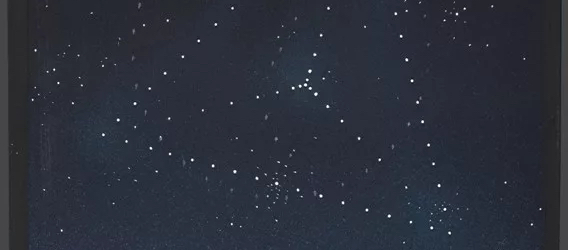Which artists ' work was completely permeated by the theme of space and the starry sky?
Cosmonautics Day is coming soon! Let's remember the most unobvious and beautiful works about space! For example, I have projects of Francisco Infante-Aran on the reconstruction of the starry sky.

Of course, the theme of space has penetrated the work of many artists of the XX century. The first human spaceflight had as strong an impact on art as the test of the first atomic bomb (and so the whole trend was born – the so-called “atomic art”). First of all, the works of Francisco Infante-Aran and his art group ARGO (Author's Working Group) really come to mind, in which artists demonstrated their passion for the idea of human migration into space, which was popular at that time.
Nevertheless, for the first time the theme of space was heard in the works of Russian avant-garde artists, in particular in the suprematist works of Kazimir Malevich and his students! Working on projects of residential buildings (plans), Malevich created a universal formula for transferring geometric abstract drawings to three-dimensional space. As a result, Malevich's suprematist compositions developed into full-fledged futuristic buildings, in which, as the artist himself dreamed, all people – “earthlings” – would be resettled.
Malevich's philosophical works and his work on urban planning projects for the future had a strong influence on his students and followers. Suprematism, in my opinion, becomes for these artists a universal visual language that allows them to better portray the idea of progress and open space.
For example, Ilya Chashnik, a direct student of Malevich, writes the work ” Red Circle on a Black Surface “(1925), in which a bunch of Malevich's “supremes” – a spaceship-tends to the planetary red circle that occupies most of the composition (Chashnik's black background of space instead of Malevich's white background).
Supremacist architect Lazar Khidekel (also one of Malevich's students) develops the ideas of his teacher and works on creating residential buildings for future earthlings. Following El Lissitsky and his protons, he dreams of the possibility of resettling people in space. This is a real spatial reinterpretation of the forms of suprematism.
Some artists of this time moved away from Malevich's rationalism and turned to the philosophical trend of cosmism, the main ideologist of which is N. F. Fedorov. He was one of the first to formulate the idea of human space exploration, and his philosophy had a significant influence on Tsiolkovsky.
Fyodorov's philosophy of Russian cosmism is clearly expressed in the works of another Russian artist of the early 20th century, Vasily Chekrygin (for example, “The Migration of Man to the Stars”, 1922).
The first person who comes to mind, of course, is Gennady Golobokov (1935-1978), a Soviet artist and poet, the founder of the direction of “psychological fiction” in painting. Golobokov literally broke into the world of fantastic illustration in 1973, winning first place at the exhibition “Space of Tomorrow”. The subjects of his paintings are scientists of the future, engineers, space explorers, their relatives and friends. Some explore ancient finds, study the flora of other planets, develop new technologies, others see off and meet their relatives from space. Like all the art of the Soviet Union, his work is imbued with heroism, hard work, courage and dedication. It is a pleasure to look at such a future.
Meanwhile, the fate of the artist himself is very tragic. At the age of 16, jumping from a steep bank into a river, Gennady suffered a fracture of the cervical spine and since then has been practically unable to move independently. Through pain and hard work, Gennady was able to finish school and enter the Moscow Correspondence University of Arts. Learn more. Draw while sitting and lying down. And despite this, inspire young people with a bright future.
I want to mention one more important point that has little to do with the artist, but must be noted in this topic. I remember my Soviet childhood (the first nine years ) very well. And we knew the names of science fiction writers Strugatsky, Kir Bulychev, Efremov… and then there was Alexey Tolstoy , the great Russian science fiction writer. We have shown many fantastic films, including those for children, such as:” Boys in the universe”,” Moscow – Cassiopeia”,”Guest from the future”. There were songs. Young hearts were surprised, inspired and admired by the exploits of the main characters. We grew up with the desire to become scientists and astronauts. Such a country definitely had a future. Scientific and technical future. What modern science fiction writers can we name? I don't know. Yes, I don't specifically deal with this topic, but I don't hear any names. I don't really see any movies. There is not a single Russian thinker among the famous futurologists. And does such a country have a future in which not a single breakthrough idea of a writer-artist-philosopher – futurologist is discussed? Big question! Russian futurology is vital for us. It should be supported not only in the “special year”. If this topic is not given due attention at the state level, I would like to draw your attention here. We need to raise and develop Russian futurology.
I'd like to give you another example myself! This is a utopian project (one of my favorite paper projects) Georgy Krutikov's “Flying City”, his graduation project from VKhUTEIN.
1928, flying cabins, cities-communes hanging in the air. Tsiolkovsky and his ideas inspired Krutikov, who wanted to transfer rest and leisure completely to the sky, leaving the earth only for labor and production.
This project, of course, as it seems to me, is a masterpiece not only of the engineering and architectural plan, but also of the graphic one. Architectural sheets with projects and drawings here become works of art in their own right.
You can read more about the project, for example, here and here.